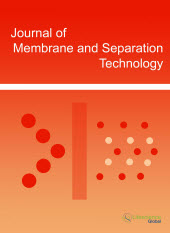jmst
Abstract : Preparation and Characterization of Superhydrophobic Modification of Polyvinylidene Fluoride Membrane by Dip-Coating
|
|
Abstract: The superhydrophobicity polyvinylidene fluoride (PVDF) membranes were modified via reducing surface energy by dip-coating perfluoroalkyl methacrylic copolymer (Zonyl 8740) onto the membranes prepared on mat glass. The chemical component of the unmodified and modified PVDF membranes surface was investigated by ATR-FTIR. Morphology and hydrophobicity of the unmodified and modified PVDF membranes were examined by scanning electronic microscopy and water contact angle, respectively. The effects of concentration of Zonyl 8740, coating time, conditions of heat treatment on hydrophobic capability of PVDF membranes were investigated. The results showed that the water contact angle increased from 141˚ to 151˚ by the dip-coating modification, therefore getting superhydrophobic PVDF membrane. Moreover, the porosity and the morphology of modified PVDF membrane were unchanged by the dip-coating modification. This results suggested that the hydrophobicty stability of the modified PVDF membrane was also good. Keywords: Polyvinylidene fluoride, Superhydrophobic, Coating modification, Perfluoroalkyl methacrylic copolymer, Membrane preparation. Download Full Article |
Abstract : Operating Conditions of Hollow Fiber Supported Liquid Membrane for Phenol Extraction from Coal Gasification Wastewater
|
|
Abstract: The extraction and recycling of phenol from high concentration coal gasification wastewater has been studied using polypropylene (PP) hollow fiber membrane and polyvinylidene fluoride (PVDF) hollow fiber membrane as liquid membrane support, the mixture of tributyl phosphate (TBP) and kerosene as liquid membrane phase, and sodium hydroxide as stripping agent in the process of extraction. The experiments investigated the effect of the operating conditions of the hollow fiber supported liquid membrane, such as aqueous phase temperature and the connection forms of membrane modules, on the extraction efficiency of phenol from high concentration coal gasification wastewater. The conclusions obtained from lab scale experiments provided guidance for scale-up experiments. So, in the scale-up experiments, three membrane modules connected in parallel, then three membrane modules connected in series were used to increase the treatment capacity and improve the treatment effect, under the operating conditions of wastewater temperature 20 ˚C, PH 7.5~8.1, flow rate 100 L/h and the concentration of stripping phase 0.1 mol/L, stripping phase flow rate 50 L/h, the extraction efficiency of the PP-TBP supported liquid membrane system was 87.02% and the phenol concentration of effluent was 218.14mg/L. And the phenol concentration of effluent met the requirements of further biodegradation treatment. Keywords: Coal gasification wastewater, Extraction efficiency, Hollow fiber membrane, Scale-up experiments. Download Full Article |
Abstract : Investigation of Membrane-Based Total Heat Exchangers with Different Structures and Materials
|
|
Abstract: Membrane-based total heat exchangers are devices to recover both sensible heat and latent heat from the exhaust air. The performances of exchangers assembled with different structures and membranes vary dramatically. To investigate performances, five modules are fabricated for comparison. A test rig is built to measure the performance of these total heat exchangers. The heat and moisture transfer in the cores are studied simultaneously. These cores can be divided into two categories: with different structures and with different membranes. For the first category, parallel-plates, plate-fins and cross-corrugated structures are used. For the second category, three kinds of membranes, i.e. one-step hand-made CA membrane, hydrophobic-hydrophilic composite membrane and machine-made CA membrane are used. The heat and mass transfer coefficients, sensible cooling and latent effectiveness are obtained through experimental measurements. The experimental results show that the cross-corrugated ducts can enhance heat and mass transfer effectively. And the one-step hand-made CA membrane has the lowest resistance in heat and moisture transfer. Keywords: Total heat exchanger, core structure, membrane materials, energy recovery, comparison.Download Full Article |
Abstract : Applications of Open Channel Membrane Modules to Treat and Reuse Wastewater
|
|
Abstract: Local utilities often face problems of domestic wastewater, local industrial wastes, storm water disposal due to existing strict regulations. For many local industries, the problem of wastewater treatment and discharge into surface reservoirs can’t be solved through the use of conventional biological treatment techniques. Current discharge standards require very strict removal of a number of impurities such as ammonia, nitrates, phosphate, etc. To reach this level of removal, modern modified biological treatment facilities (membrane bioreactors etc.) are used. This article suggests a new technical approach to treat directly domestic wastewater and storm water to completely reuse them for technical needs. The modern concept of rational water resources management requires the development of new efficient techniques that provide wastewater treatment and reuse. As RO membranes simultaneously reject all dissolved impurities such as BOD, TDS, ammonia, phosphates etc., they become very attractive for the direct treatment of wastewater without biological stage. To treat wastewater, specially designed membrane "open channel" modules are used that do not possess "dead areas" that cause fouling or require pretreatment. A solution to RO concentrate disposal problem is presented that consists of reducing of initial wastewater volume by 100 times. Concentrate is withdrawn from membrane unit as sludge moisture. The efficient use of membrane RO techniques is connected with a salt balance in water system. Thus, to provide high ecological efficiency of developed techniques, all components of water supply and wastewater discharge systems should be accounted for. Keywords: Reverse osmosis, open channel membrane module, wastewater reuse, domestic wastewater, storm water, ammonia reduction, oil reduction, car wash effluents.Download Full Article |























